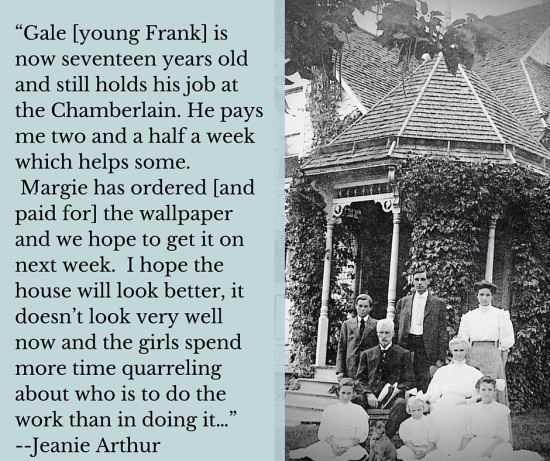When THE LAST LETTER launched in 2011 I was struck by two types of reactions from readers. One was that many people wanted to know more, they wanted to SEE more about how the Arthurs lived in the seventeen years between the two plotlines.  And the second bit of feedback I got from some very angry readers was that they could not believe that Jeanie Arthur had, nor would they, as mothers, EVER board their own children out like the main character did in the novel, like the real Jeanie Arthur (my great-great grandmother) did over one hundred years ago.
And the second bit of feedback I got from some very angry readers was that they could not believe that Jeanie Arthur had, nor would they, as mothers, EVER board their own children out like the main character did in the novel, like the real Jeanie Arthur (my great-great grandmother) did over one hundred years ago.
At first comments like this panicked me. Had I been sloppy with my research? Had I been too inventive in a genre that requires the author to be simultaneously creative and “stuck” to historical facts? But as I considered the response to this idea of boarding children out I decided, no. I have personal/familial/anecdotal evidence that mothers boarded children out so that they and the larger family would survive. And there are mountains of data that reveal that living at the turn of century required families and mothers to make decisions that we 21st century moms never would, that we would rarely be asked to.
The photo above shows my great-great grandmother and her six living children after her husband and their father left them—after they formally divorced. The man in the photo is Jeanie’s father. That home behind them was the center of their lives and Jeanie did everything she could to be sure that she kept that house in the family, stowing money away in banks where it would be safe from people who wanted to spend it for her. . . But keeping the house in the family meant all the children had to contribute financially. For the younger girls that meant they were often boarded at other homes. For the older children it meant they sent home money for the household. And, it often mean Jeanie took in boarders of all ages—infants to the elderly.
Like Jeanie Arthur the character, the real woman worked a multitude of jobs, scraping and scrapping together enough money to feed her children, pay for their school (yes, high school required payment in those days), and keep that house. Her letters to her son, James, are full of details related to the care and maintenance of this home, the problems with it, the endless race to secure enough in tax money that no one could take the property from her… Likewise, her letters show just one way parents thought of and discussed their offspring that was so very different, starkly so, than today (see above quote with the photo). The “quarreling daughters” stand the test of time, but we’ve certainly changed our perspective on what is required of kids today. Stay tuned for more on how divorce in early 20th century America shaped the way the Arthurs lived their lives.
And if you love fiction woven into your history, take a look at THE ROAD HOME (Book 2 in The Letter Series), a recent gold medal winner in the Readers’ Favorite Book Awards.
